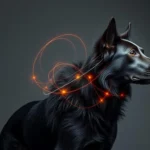
Regular health care is crucial for our furry companions, and one of the most important aspects of that care is understanding their vision. Canine vision is quite different from human vision, making it essential for dog owners to recognize the signs that their dog might be experiencing vision loss. How can you tell if your dog is going blind? This question will guide us through the signs, causes, and treatments of blindness in dogs, enabling you to take proactive steps in your dog’s health care.
Understanding Dog Vision
Anatomy of a Dog’s Eye
To fully grasp how dogs see the world, it’s essential to understand the basic structure of a dog’s eye. A dog’s eye consists of several critical components:
- Cornea: The clear front surface that helps focus light.
- Lens: Adjusts to help the dog focus on objects at varying distances.
- Retina: Contains light-sensitive cells that send visual information to the brain.
Dogs have a higher number of rod cells than humans, giving them excellent night vision. However, they have fewer cone cells, which means they see fewer colors and their overall vision is less sharp than that of humans. This unique anatomy allows dogs to excel in low-light conditions but may also make them susceptible to various eye diseases.
Common Eye Problems in Dogs
Several common eye conditions can lead to blindness if not treated promptly. These include:
- Cataracts: Clouding of the lens that can impede vision.
- Glaucoma: Increased pressure in the eye that can damage the optic nerve.
- Retinal Diseases: Conditions such as retinal dysplasia or progressive retinal atrophy that can lead to degeneration of the retina.
Recognizing these conditions early is essential, as they can progress to complete blindness if not addressed.
Signs Your Dog Might Be Going Blind
Behavioral Changes
One of the first indicators that your dog may be losing its vision is noticeable behavioral changes. You might observe:
- Reluctance to Go for Walks or Play: If your dog used to enjoy walks and playtime but suddenly becomes hesitant, it may be struggling with its vision.
- Increased Anxiety or Fearfulness: Dogs may feel insecure in new environments or experience increased anxiety when they cannot see clearly.
Physical Signs
In addition to behavioral changes, there are physical signs to watch for:
- Cloudy or Discolored Eyes: A cloudy appearance in the eyes can indicate cataracts or other conditions.
- Changes in Pupil Size or Reaction to Light: If your dog’s pupils appear unusually dilated or do not respond to light as expected, this could be a sign of vision problems.
Vision Tests You Can Perform
You can conduct simple vision tests at home to gauge your dog’s eyesight. Consider these activities:
- Observe Response to Visual Cues: Move your hand or a toy in front of your dog and see if it follows your movements.
- Light Test: Shine a flashlight at a safe distance and observe if your dog reacts to the light.
These tests can help you assess whether your dog’s vision is deteriorating, but they are not a substitute for a professional evaluation.
Causes of Blindness in Dogs
Genetic Factors
Some dog breeds are genetically predisposed to eye diseases. Breeds like:
- Cocker Spaniels
- Poodles
- Siberian Huskies
These breeds often have higher incidences of cataracts and other eye issues, making it crucial for owners to be vigilant.
Age-Related Changes
As dogs age, they often experience age-related changes in their vision. The lenses of their eyes can become denser, leading to cataracts, while the retina may also deteriorate, impacting sight. Regular veterinary check-ups can help identify these changes early.
Health Conditions
Certain health conditions can also contribute to blindness in dogs:
- Diabetes: This condition can lead to cataracts and other eye complications.
- Hypertension: High blood pressure can damage the eyes, resulting in vision loss.
Monitoring your dog’s overall health is vital, as many systemic conditions can have ocular manifestations.
What to Do If You Suspect Your Dog Is Going Blind
Schedule a Veterinary Appointment
If you suspect that your dog is experiencing vision loss, the first step is to schedule a veterinary appointment. A professional evaluation is critical for diagnosing the issue accurately. During a veterinary eye exam, your vet will conduct several tests to assess your dog’s vision and overall eye health.
Preparing for the Vet Visit
To ensure a productive visit, prepare a list of questions to ask your vet, such as:
- What tests will be performed to assess my dog’s vision?
- Are there specific treatments available for my dog’s condition?
- Should I make any environmental changes to accommodate my dog’s needs?
Also, provide your veterinarian with information about any changes in your dog’s behavior or physical appearance, as this can aid in diagnosis.
Treatment Options for Blindness in Dogs
Medical Treatments
Depending on the diagnosis, there are various medical treatments available:
- Medications: Corticosteroids may help reduce inflammation in certain conditions.
- Surgery: Surgical options, like cataract surgery, can restore vision in some cases.
Your veterinarian will discuss the most appropriate treatment plan based on your dog’s specific needs.
Supportive Care at Home
If your dog is diagnosed with blindness or significant vision impairment, implementing supportive care at home is essential. Consider:
- Environmental Modifications: Keep furniture in the same place, use textured mats to help your dog navigate, and avoid obstacles that could pose risks.
- Training: Teach your dog verbal cues and commands to help them navigate their environment confidently.
With patience and care, many blind dogs can lead happy, fulfilling lives.
Prevention and Maintenance of Dog Eye Health
Regular Check-Ups
One of the best ways to maintain your dog’s eye health is through regular veterinary check-ups. Routine visits can catch potential issues early, allowing for timely intervention.
Proper Nutrition
A well-balanced diet contributes significantly to eye health. Consider incorporating foods rich in:
- Omega-3 fatty acids
- Antioxidants like vitamins A, C, and E
These nutrients can support overall vision and eye health.
Safe Environment
Creating a safe home for dogs with vision issues is crucial. Ensure that the living space is free from hazards, such as sharp objects or slippery floors. This safety net can help your dog feel secure and prevent accidents.
Conclusion
Recognizing the signs of vision loss in dogs is vital for timely intervention and care. Understanding how can you tell if your dog is going blind empowers owners to act quickly, ultimately enhancing their pet’s quality of life. By taking proactive steps in health care, including regular check-ups, proper nutrition, and environmental modifications, you can ensure that your dog remains healthy and happy for years to come. The bond between dogs and their owners is built on love and compassion, and being aware of their health needs is a vital part of that relationship.









